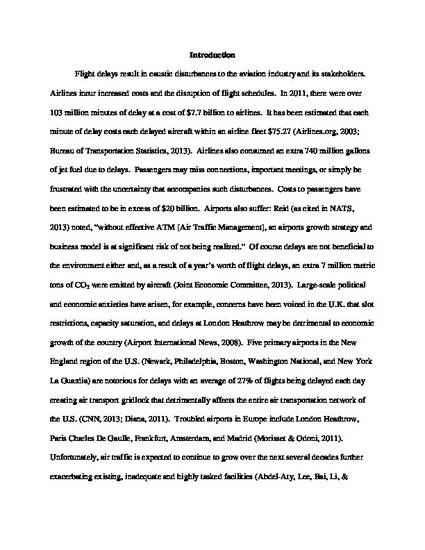
- air traffic control,
- delays,
- air traffic management
Since the September 11, 2001 attacks, worldwide air traffic has steadily been increasing towards peak levels reported from 2000 to 2001 (Federal Aviation Administration [FAA], 2011). Although U.S. system-wide traffic is still around 10% less than the highest volumes, congestion at particular airports prone to delays, such as Newark, Philadelphia, New York LaGuardia, and New York Kennedy, is up nearly 10% from 2000 metrics. Other airports, such as Chicago O’Hare and Atlanta in the U.S. and London Heathrow, Madrid, and Istanbul in Europe, are seemingly continually plagued with flight delays regardless of variations in traffic (FAA, 2012). According to the Bureau of Transportation Statistics (2013), the best flight punctuality rate among the 29 largest primary U.S. airports in January 2012 was 89.7% with the worst being 77.2%. In Europe, 14 major airports reported arrival delays in excess of 15 minutes for more than 25% of flights (FAA, 2012). Air traffic forecasts through 2031 indicate that both the passenger volume and the number of transport aircraft will be double that of 2012 levels. Considering many of the aforementioned airports are operating near or beyond capacity, it is likely that air traffic delays will only get worse (Airbus, 2012). The importance of delay management is critical to a variety of stakeholders from passengers to air carrier operations management to air traffic control personnel. Reliable delay prediction can mitigate the snowball effects delays can have on the air traffic management system and air carrier structures (Xu, Sherry, & Laskey, 2008). A variety of studies have been implemented to study air traffic delays but generally focus on a system-wide approach that includes arrival, enroute, and departure delays (Brooker, 2009; Coy, 2006; Santos & Robin, 2011; Xu, Sherry, & Laskey, 2008). Alternatively, others have focused on individual airports and their potential influence on the whole air traffic management system (Nayak & Zhang, 2011). More research on the factors associated with and prediction of airport-related delays have been advocated (Brooker, 2009; Coy, 2006; Nayak & Zhang, 2011; Santos & Robin, 2011; Xu, Sherry, & Laskey, 2008). Ideally, an improved model with predictive capabilities would assist in planning for and potentially mitigating negative effects of airport-based arrival congestion. The goal of this pilot study is to begin the construction of an improved airport delay prediction model by exploring potentially influential air traffic management principles. Utilizing expert panel-based model and procedural improvement techniques similar to those used in medical and technical fields, this study aims to bolster existing airport arrival delay prediction models (Deason & Jefferson, 2010; Estes, 2008; Gisev, Bell, O’Reilly, Rosen, & Chen, 2010). In this Phase I pilot study, a purposeful sample of air traffic control instructors, college faculty, and air traffic controllers will be asked to generate a list of air traffic management principles that influence airport arrival efficiency. This data will be utilized to create subsequent phases which will include a Delphi Panel to rank the identified principles, confirmatory analysis, statistical modeling, and model testing.
Available at: http://works.bepress.com/linda-weiland/4/
